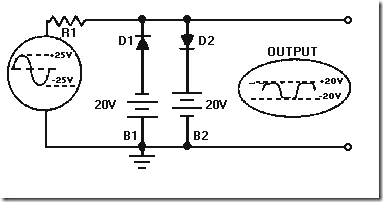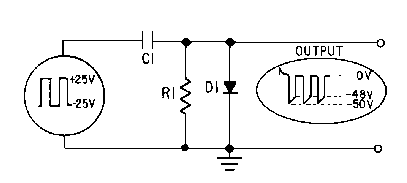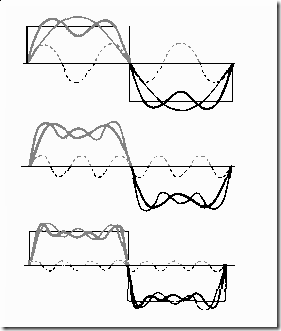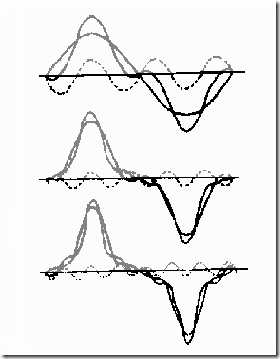SUMMARY
This chapter has presented information on wave shaping. The information that follows summarizes the important points of this chapter.
A LIMITER is a device which limits or prevents some part of a waveform from exceeding a specified value.
In a SERIES LIMITER, the diode is in series with the output. It can limit either the negative or positive alternation of the input signal.
In a SERIES-POSITIVE LIMITER, the diode is in series with the output which is taken across the resistor. It removes the positive alternation of the input signal.
In a SERIES-POSITIVE LIMITER WITH BIAS, the bias potential will either aid or oppose the flow of current. When aiding forward bias, only a portion of the positive input pulse is removed. When the bias aids the reverse bias, all of the positive and a portion of the negative pulse is removed.
The SERIES-NEGATIVE LIMITER limits the negative portion of the input pulse. The difference between a series-negative limiter and a series-positive limiter is that the diode is reversed in the negative limiter.
A SERIES-NEGATIVE LIMITER with bias is the same as the series-positive limiter with bias, but the outputs are opposite. When bias aids forward bias, only a portion of the negative input is removed. When bias aids reverse bias, all of the negative and a portion of the positive input is removed.
In a PARALLEL LIMITER, a resistor and diode are connected in series with the input signal. The output is taken across the diode.
In the PARALLEL-POSITIVE LIMITER, the positive portion of the input signal is limited when the diode conducts.
The PARALLEL-NEGATIVE LIMITER diode is reversed from that of the parallel positive limiter to limit only a portion of the negative input signal.
The DUAL-DIODE LIMITER combines the parallel negative limiter with negative bias (reverse bias) and the parallel positive limiter with positive bias (reverse bias). It will remove parts of the positive and negative input signal.
A CLAMPING CIRCUIT effectively clamps or ties down the upper or lower extremity of a waveform to a fixed dc potential. Clamping does not change the amplitude or shape of the input waveform.
A POSITIVE CLAMPER will clamp the lower extremity of the input waveform to a dc potential of 0 volts.
A NEGATIVE CLAMPER will clamp the upper extremity of the input waveform to a dc potential of 0 volts.
A COMMON-BASE TRANSISTOR CLAMPER clamps the collector voltage to a reference level. A waveform other than a sine wave is called a COMPLEX WAVE.
If the odd harmonics of a sine wave are added algebraically, the result is a square wave. A PERFECT SQUARE WAVE is composed of an infinite number of odd harmonics in phase with the fundamental wave.
A SAWTOOTH WAVE is made up of different harmonics, both odd and even.
A PEAKED WAVE is made up of odd harmonics that are in phase and out of phase with the fundamental.
INTEGRATION takes place in an RC circuit with the output taken across the capacitor. The amount of integration is dependent upon the time constant of the circuit. Full integration takes place when the time constant of the RC circuit is at least 10 times greater than the duration of the input pulse. An RL circuit is also used as an integration circuit. The output is taken across the resistor and the time constant of the circuit is 10 times greater than the input pulse.
DIFFERENTIATION is the opposite of integration. In the differentiator, the output is taken across the resistor. Full differentiation takes place when the time constant of the circuit is 1/10 that of the input pulse.
A COUNTING CIRCUIT receives uniform pulses, representing units to be counted, and produces a voltage output proportional to its frequency.
ANSWERS TO QUESTION Q1. THROUGH Q27.
A1. Negative. A2. Positive. A3. Biasing. A4. The diode.
A5. Conducting, cutoff. A6. Short time constant. A7. Long time constant. A8. Most negative.
A9. Positive potential.
A10. Positive clamper with negative bias. A11. Most positive.
A12. Negative potential. A13. Positive bias. A14. -5 volts.
A15. It is composed of an infinite number of odd harmonics in phase with the fundamental. A16. It is composed of odd harmonics some of which are out phase with the fundamental.
A17. All the odd harmonics are in phase with the fundamental in the square wave. This is not true of the odd harmonics in the peaked wave.
A18. The time constant is long and the output is taken across the capacitor in an RC circuit. A19. A pure sine wave cannot be integrated; it contains no harmonics.
A20. The ability of the inductor to oppose a change in current.
A21. The time-constant value of a long time constant-circuit is 10 times the value of the input pulse duration. The short time-constant circuit has a time constant of 1/10 of the pulse duration.
A22. A more complete integration of the waveform would result from the long time constant.
A23. In an RC circuit the output is taken across the resistor. In the RL circuit the output is taken across the inductor.
A24. Frequency counters or frequency dividers. A25. The frequency of the voltage input.
A26. To provide a quick discharge path for C1.
A27. The load resistor in a positive counter is replaced by a capacitor in a step counter.














